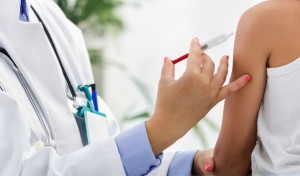By Sayer Ji
Contributing Writer for Wake Up World
A new review published in Autoimmunity Reviews titled, “On the relationship between human papilloma virus vaccine and autoimmune disease,” is destined to reopen the controversy surrounding numerous reports of HPV vaccine-induced harm that have surfaced ever since their widespread use, beginning with the FDA’s 2006 approval of Merck & Co.’s Gardasil.[i]
The study points out, “Along with the introduction of the HPV vaccines, several cases of onset or exacerbations of autoimmune diseases following the vaccine shot have been reported in the literature and pharmacovigilance databases, triggering concerns about its safety.”
[pro_ad_display_adzone id=”110028″]
Following an extensive review of the biomedical literature, they listed conditions in which HPV vaccination is most likely linked to the development of autoimmune diseases (with qualification that they are only raising possible links and not fully confirmed ones), including:
– Acute disseminated encephalomyelitis and other demyelinating diseases of the central nervous system
– Multiple sclerosis (MS)
– Guillain–Barré syndrome (GBS)
– Primary ovarian failure (POF)
– IgA bullosus dermatitis
– Henoch-Schonlein purpura
– Cutaneous vasculitis
– Kikuch-Fujimoto disease
– Erythema multiforme
– Acute cerebral ataxia
– Immune thrombocytopenic purpura
The authors caution that, “The decision to vaccinate with HPV vaccine is a personal decision, not one that must be made for public health. HPV is not a lethal disease in 95% of the infections; and the other 5% are detectable and treatable in the precancerous stage.”
HPV Vaccines May Cause The Immune System To Attack Body
How could a vaccine that has been declared safe and effective the world over be connected to such a wide range of autoimmune diseases?
Part of the explanation lies with a phenomena known as ‘molecular mimicry,’ defined as the possibility that the immune system will mistake a self-structure with a foreign (usually pathogen derived) peptide and thereby cause auto-immune harm. Antibodies, for instance, which are produced against a specific pathogen can cross-react with proteins in the body that have a similar or identical sequence.
Exactly this possibility is addressed in a groundbreaking article titled, “Quantifying the possible cross-reactivity risk of an HPV16 vaccine,” published in 2009 in the Journal of Experimental Therapeutics and Oncology. The article describes the background for the topic as follows:
The potential adverse events associated with vaccination for infectious diseases underscore the need for effective analysis and definition of possible vaccine side effects. Using the HPV16 proteome as a model, we quantified the actual and theoretical risks of anti-HPV16 vaccination, and defined the potential disease spectrum derived from concomitant cross-reactions with the human organism.
The HPV16 proteome is the entire spectrum of proteins produced by the HPV16 virus, which are present within both the Gardasil and Cervarix HPV vaccines. Each protein carries a risk of inducing an immune response that could, in theory, ‘blow back’ on self-structures within the human proteome. With this possibility in mind, the researchers used the following method to ascertain the likelihood of such an event:
We searched the primary sequence of the HPV16 proteome for heptamer amino acid sequences shared with human proteins using the Protein International Resource database.
Heptamer amino acid sequences are defined as an oligomers (molecular complex) with seven subunits.
The results of their search revealed a profound degree of matching:
The human proteome contains 82 heptapeptides and two octapeptides found in HPV16. The viral matches are spread among proteins involved in fundamental processes, such as cell differentiation and growth and neurosensory regulation. The human proteins containing the HPV16-derived heptamers include cell-adhesion molecules, leukocyte differentiation antigens, enzymes, proteins associated with spermatogenesis, transcription factors, and neuronal antigens. The number of viral matches and their locations make the occurrence of side autoimmune cross-reactions in the human host following HPV16-based vaccination almost unavoidable. [emphasis added]
The so-called “unavoidability” of “side autoimmune cross reactions in the human host following HPV16-based vaccination” is a huge concern, especially considering that there are 4 strains in total in the Gardasil vaccine and 2 in the Cervarix, increasing the range of proteomic overlap between viral and human proteins and subsequent molecular mimicry significantly. Also, it is important to acknowledge that the vaccine has never even been found to prevent one single case of death from cervical cancer, and yet millions are being exposed to what are likely its unavoidable health risks.
HPV Vaccines Don’t Work As Advertised and Lack Safety
In an article published in 2013 in the journal Infectious Agent Cancer, titled “HPV vaccines and cancer prevention, science versus activism,” the rationale behind current worldwide HPV vaccination programs is called into question.
The basic premise of global immunization campaigns are described as follows:
1) that HPV vaccines will prevent cervical cancers and save lives and, 2) have no risk of serious side effects. Therefore, efforts should be made to get as many pre-adolescent girls vaccinated in order to decrease the burden of cervical cancer.
Despite this, the authors claim, “Careful analysis of HPV vaccine pre- and post-licensure data shows however that both of these premises are at odds with factual evidence and are largely derived from significant misinterpretation of available data.”
How so?
The authors explain:
In spite of much unwarranted and premature optimism, the fact is however that HPV vaccines have not thus far prevented a single case of cervical cancer (let alone cervical cancer death). Instead, what the clinical trials have shown is that HPV vaccines can prevent some of the pre-cancerous CIN 2/3 lesions associated with HPV-16 and HPV-18 infection, a large fraction of which would spontaneously resolve regardless of the vaccination status [2–4]. For example, in adolescent women aged 13 to 24 years, 38% of CIN 2 resolve after one year, 63% after two and 68% after three years [5]. Moreover, the validity of CIN 2 being a cancer precursor is questionable due to high misclassification rates and poor intra- and inter-observer reproducibility in diagnosis, as well as high regression rates [6–9]. According to Castle et al. [7] CIN 2 is the least reproducible of all histopathologic diagnoses and may in part reflect sampling error. While CIN 3 is a more reliable marker for cancer progression than CIN 2, the use of this marker is not without caveats [2,10].
Moreover, the presumed safety of HPV vaccines is not supported by the facts:
Similarly, the notion that HPV vaccines have an impressive safety profile can only be supported by highly flawed design of safety trials [2,13] and is contrary to accumulating evidence from vaccine safety surveillance databases and case reports which continue to link HPV vaccination to serious adverse outcomes (including death and permanent disabilities) [2,4,14]. For example, compared to all other vaccines in the U.S. vaccination schedule, Gardasil alone is associated with 61% of all serious adverse reactions (including 63.8% of all deaths and 81.2% cases of permanent disability) in females younger than 30 years of age [12].
Although a report to a vaccine safety surveillance system does not by itself prove that the vaccine caused an adverse reaction, the unusually high frequency of adverse reactions related to HPV vaccines reported worldwide, as well as their consistent pattern (i.e. nervous system-related disorders rank the highest in frequency), points to a potentially causal relationship [2]. Furthermore, matching the data from vaccine surveillance databases is an increasing number of case reports documenting similar serious adverse reactions associated with HPV vaccine administration, with nervous system and autoimmune disorders being the most frequently reported in the medical literature [15–24].
The article summarizes their findings as follows:
In summary, the optimistic claims that HPV vaccines will prevent cervical cancers and save lives, and that they are extremely safe, rest on assumptions which are misinterpreted and presented to the public as factual evidence. We thus conclude that further reduction of cervical cancers might be best achieved by optimizing cervical screening (which carries no serious health risks) and targeting other factors of the disease rather than by the reliance on vaccines with questionable efficacy and safety profiles [2,25].
Concluding Remarks
Considering also the recent discovery that HPV vaccines aren’t effective at protecting African-American women, policy-makers need to reformulate their message for a wide range of reasons. The fact that the vaccines aren’t nearly as effective as advertised, and clearly lack industry independent assurance of their safety, brings to the question the issue of informed consent. If the public is not being provided with the information required to make an informed choice, and immunization policy is based upon cultivating faith in a higher authority and not the evidence itself, clearly, the time has come for people to take back control of their own health, beginning perhaps with exploring the primary literature on the topic themselves in greater depth.
For additional research on HPV vaccine linked adverse effects, use our database section on the topic: HPV Vaccine Adverse Effects.
Article Reference
[i] Merck Reports Double-Digit Earnings-Per-Share Growth for Second Quarter 2007
Further articles by Sayer Ji:
- Roundup Weedkiller Found In 75% of Air and Rain Samples, Government Study Finds
- Live Flu Vaccines Increase Infectious Bacteria Counts 100-Fold in Mice
- FAIL: Another Mammography Study Finds They Don’t Save Lives
- MSG Proven Highly Toxic: 1 Dose Causes Headache In Healthy Subjects
- Black Seed Extract ‘Cures’ HIV Patient Naturally
- The Grain That Damages The Human Brain
- The Cancer-Causing Metal Millions Eat, Wear or Have Injected Into Their Kids
- Biophotons: The Human Body Emits, Communicates with, and is Made from Light
- The 2013 Measles Outbreak: A Failing Vaccine, Not A Failure To Vaccinate
- 3 Evidence-Based Ways To Reverse Skin Aging Naturally
- Why Is The Food Industry Poisoning Us With Trillions of Nanoparticles?
- How to Clean Your Arteries With One Simple Fruit
- 13 Evidence-Based Medicinal Properties of Coconut Oil
About the author:
Sayer Ji is an author, researcher, lecturer, an advisory board member of the National Health Federation, and the founder of GreenMedInfo.com, the world an open access, evidence-based resource supporting natural and integrative modalities. His writings have been published and referenced widely in print and online, including Truthout, Mercola.com, The Journal of Gluten Sensitivity, New York Times and The Well Being Journal.
In 1995 Sayer received a BA degree in Philosophy from Rutgers University, where he studied under the American philosopher Dr. Bruce W. Wilshire, with a focus on the philosophy of science. In 1996, following residency at the Zen Mountain Monastery in upstate New York, he embarked on a 5 year journey of service as a counsellor-teacher and wilderness therapy specialist for various organizations that serve underprivileged and/or adjudicated populations. Since 2003, Sayer has served as a patient advocate and an educator and consultant for the natural health and wellness field.
[pro_ad_display_adzone id=”110027″]







